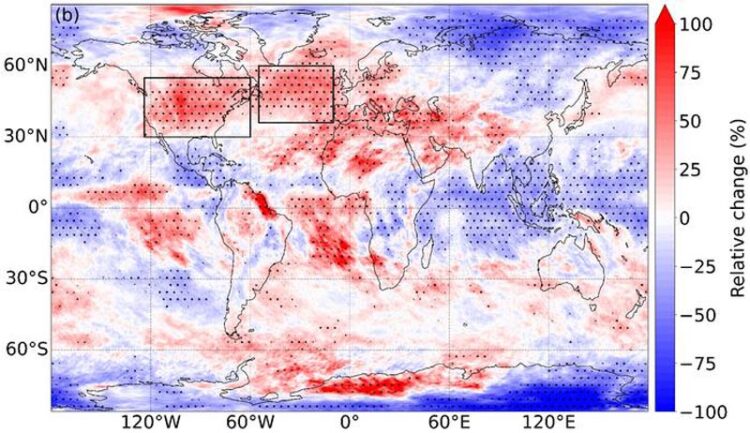Aviation turbulence strengthened as the world warmed

Figure depicting turbulence increase from 1979 to 2020
Credit: Mark Prosser et al.
The skies aircraft fly through are bumpier today than four decades ago, scientists have found, after producing a new analysis showing that turbulence has increased as the climate changed.
New research from the University of Reading shows that clear-air turbulence, which is invisible and hazardous to aircraft, has increased in various regions around the world.
At a typical point over the North Atlantic – one of the world’s busiest flight routes – the total annual duration of severe turbulence increased by 55% from 17.7 hours in 1979 to 27.4 hours in 2020, the research found. Moderate turbulence increased by 37% from 70.0 to 96.1 hours, and light turbulence increased by 17% from 466.5 to 546.8 hours.
The team behind the study, which is published today (Thursday, 8 June) in Geophysical Research Letters, say the increases are consistent with the effects of climate change. Warmer air from CO2 emissions is increasing windshear in the jet streams, strengthening clear-air turbulence in the North Atlantic and globally.
PhD researcher Mark Prosser said: “Turbulence makes flights bumpy and can occasionally be dangerous. Airlines will need to start thinking about how they will manage the increased turbulence, as it costs the industry $150–500m annually in the USA alone. Every additional minute spent travelling through turbulence increases wear-and-tear on the aircraft, as well as the risk of injuries to passengers and flight attendants.”
While the USA and North Atlantic have experienced the largest increases, the new study found that other busy flight routes over Europe, the Middle East, and the South Atlantic also saw significant increases in turbulence.
Professor Paul Williams, an atmospheric scientist at the University of Reading who co-authored the study, said: “Following a decade of research showing that climate change will increase clear-air turbulence in the future, we now have evidence suggesting that the increase has already begun. We should be investing in improved turbulence forecasting and detection systems, to prevent the rougher air from translating into bumpier flights in the coming decades.”
Journal: Geophysical Research Letters
DOI: 10.1029/2023GL103814
Method of Research: Data/statistical analysis
Subject of Research: Not applicable
Article Title: Evidence for Large Increases in Clear‐Air Turbulence Over the Past Four Decades
Article Publication Date: 8-Jun-2023
Media Contact
Ollie Sirrell
University of Reading
o.j.sirrell@reading.ac.uk
All latest news from the category: Earth Sciences
Earth Sciences (also referred to as Geosciences), which deals with basic issues surrounding our planet, plays a vital role in the area of energy and raw materials supply.
Earth Sciences comprises subjects such as geology, geography, geological informatics, paleontology, mineralogy, petrography, crystallography, geophysics, geodesy, glaciology, cartography, photogrammetry, meteorology and seismology, early-warning systems, earthquake research and polar research.
Newest articles

Innovative 3D printed scaffolds offer new hope for bone healing
Researchers at the Institute for Bioengineering of Catalonia have developed novel 3D printed PLA-CaP scaffolds that promote blood vessel formation, ensuring better healing and regeneration of bone tissue. Bone is…

The surprising role of gut infection in Alzheimer’s disease
ASU- and Banner Alzheimer’s Institute-led study implicates link between a common virus and the disease, which travels from the gut to the brain and may be a target for antiviral…

Molecular gardening: New enzymes discovered for protein modification pruning
How deubiquitinases USP53 and USP54 cleave long polyubiquitin chains and how the former is linked to liver disease in children. Deubiquitinases (DUBs) are enzymes used by cells to trim protein…



